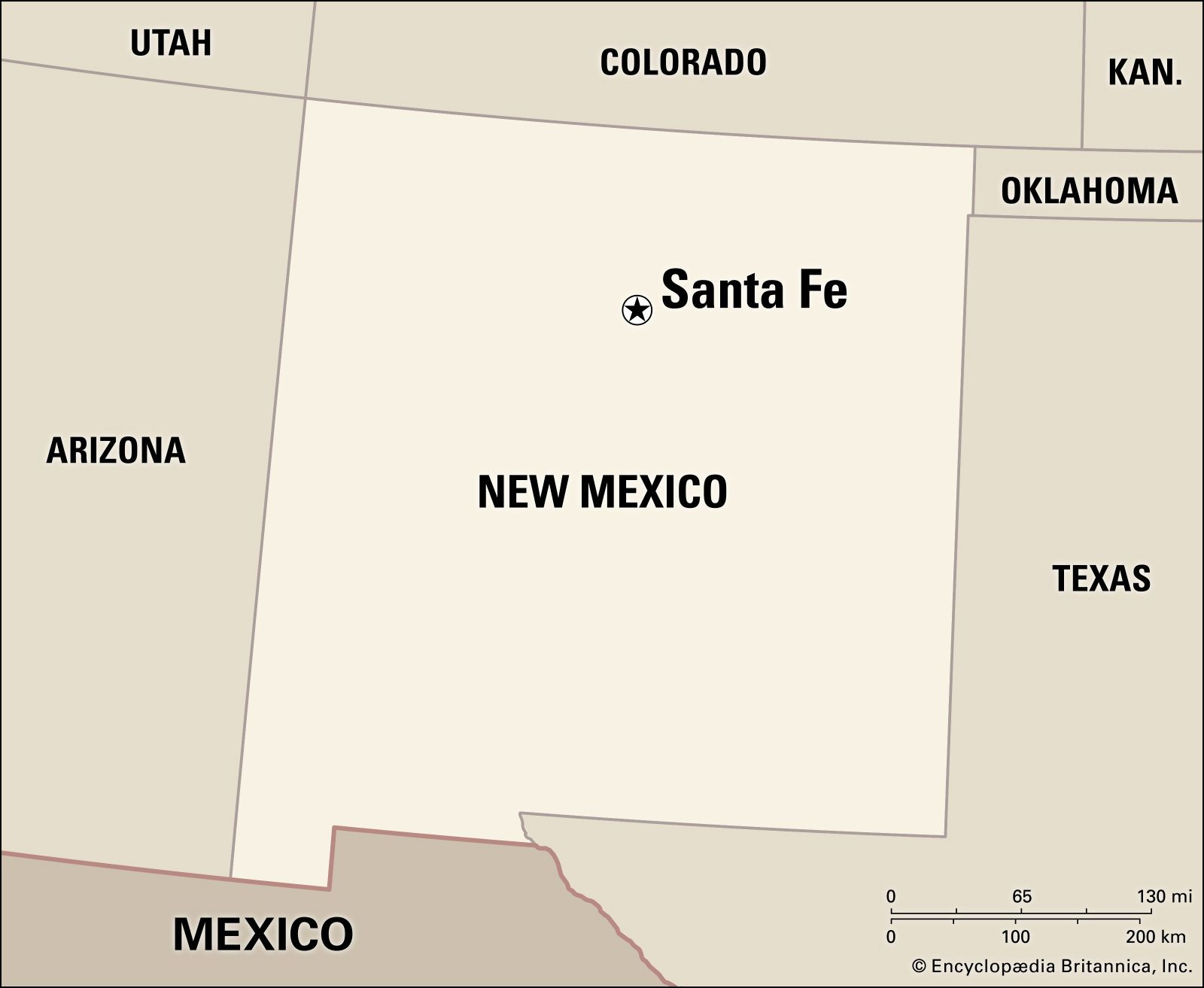Santa Fe, the capital city of New Mexico, is a destination rich in history, culture, and stunning landscapes. Nestled in the northern Rio Grande valley at the foot of the Sangre de Cristo Mountains, Santa Fe stands at an elevation of 6,996 feet (2,132 meters) above sea level. Its invigorating, dry climate has long attracted visitors, making it a popular summer retreat and a haven for winter sports enthusiasts drawn to mountain skiing.
A City Steeped in History: Founding and Early Years
Founded in 1610 by Governor Don Pedro de Peralta, Santa Fe holds the distinction of being the oldest capital city in the United States. Originally named Villa Real de la Santa Fé de San Francisco de Asis, meaning “Royal City of the Holy Faith of St. Francis of Assisi,” the city was meticulously planned around a central plaza, a design that remains a focal point today. However, the early years were not without turmoil. In 1680, the Pueblo Rebellion forced the Spanish settlers to evacuate. It wasn’t until 1692 that Don Diego de Vargas peacefully retook Santa Fe, an event still celebrated annually with a vibrant fiesta, commemorating the city’s resilience and enduring spirit.
During the 18th century, Santa Fe flourished as the administrative, military, and missionary center for a vast, yet sparsely populated Spanish colonial frontier province. This strategic importance laid the groundwork for its future role as a pivotal city in the American Southwest.
Santa Fe’s Role in American History: From the Santa Fe Trail to Statehood
American interest in Santa Fe began to grow following reports from Lieutenant Zebulon M. Pike, who was held prisoner in the city during his exploration of the Southwest in 1806. After Mexico gained independence in 1821, Santa Fe became a vital hub for commerce, particularly with the development of the famous Santa Fe Trail. This bustling wagon trail facilitated a brisk trade and further integrated the region into the broader economic landscape.
The Mexican War marked a significant turning point. In 1846, U.S. forces under General Stephen Watts Kearny occupied Santa Fe, and by 1847, an English-language newspaper was being published within its boundaries, signaling a cultural shift. Following the cession of New Mexico to the United States in 1848, Santa Fe officially became the capital of the Territory of New Mexico in 1851, and upon statehood in 1912, it retained its status as the New Mexico Capital City. Even amidst the turmoil of the American Civil War, Santa Fe briefly found itself under Confederate occupation in 1862, before quickly returning to Union control. The arrival of the railroad in 1880 further cemented Santa Fe’s role as a trading center for ranchers, farmers, and Native American communities, though brief mining booms in the nearby mountains also contributed to its economy.
Modern Santa Fe: Culture, Tourism, and Economy
The establishment of the Los Alamos Scientific Laboratory (now Los Alamos National Laboratory) in the early 1940s, located just 35 miles (56 km) northwest of Santa Fe, injected new economic vitality into the region. This influx of scientific and technological development complemented Santa Fe’s already established cultural and historical significance.
 Aerial view of Santa Fe, New Mexico showcasing historic architecture
Aerial view of Santa Fe, New Mexico showcasing historic architecture
Today, Santa Fe thrives as the cultural capital of the Southwest, attracting tourists and new residents alike. Its rich Spanish-American heritage is palpable, and the city is experiencing rapid growth as a commercial and residential center. Built upon the site of a prehistoric Tiwa pueblo, Santa Fe continues to be a site of significant archaeological interest.
Architectural and Cultural Landmarks in New Mexico’s Capital
Santa Fe boasts numerous landmarks that reflect its layered history and cultural richness. The Palace of the Governors, originally built in 1610 by Peralta, stands as a testament to the city’s colonial past and was beautifully restored as a museum in 1914. The city has consciously preserved its unique architectural character since 1958 through zoning ordinances that protect the traditional Spanish-Pueblo Indian style.
Religious landmarks also punctuate the cityscape, including the Chapel of San Miguel, known as the Oldest Church, with origins in the 17th century and rebuilt in 1710, and the impressive Cathedral of St. Francis, constructed in 1869 by Bishop John B. Lamy. These sites not only offer architectural splendor but also provide insights into the spiritual and cultural fabric of Santa Fe. Literature has also immortalized Santa Fe, most notably through Willa Cather’s novel Death Comes for the Archbishop (1927), a fictionalized account of Bishop Lamy’s life and work in the region.
For art and culture enthusiasts, Santa Fe is a treasure trove. The Museum of New Mexico encompasses several renowned institutions, including the Palace of the Governors, the Museum of International Folk Art, the Museum of Fine Arts, and the Museum of Indian Arts and Culture. These museums collectively offer a deep dive into the history, art, and cultural traditions of the Southwest and beyond. Additionally, the Wheelwright Museum of the American Indian provides further exploration of Indigenous art and culture. Santa Fe is also home to notable educational institutions like the College of Santa Fe and St. John’s College, as well as specialized schools such as the Santa Fe Indian School and the New Mexico School for the Deaf, contributing to its vibrant intellectual environment.
Santa Fe’s legacy also includes pioneering figures like Nina Otero-Warren, a leader in the women’s suffrage movement in New Mexico and a trailblazer in politics and education. Her recognition in the American Women Quarters Program in 2022 underscores the significant contributions of women from Santa Fe to the broader American narrative.
As a regional hub for the National Park Service and the headquarters for the Santa Fe National Forest, Santa Fe also serves as a gateway to the natural wonders of New Mexico. Its five state monuments, overseen by the Museum of New Mexico, further enrich the visitor experience, offering a comprehensive view of the state’s heritage.
In conclusion, Santa Fe, the capital city of New Mexico, is more than just a political center; it is a vibrant tapestry of history, culture, art, and natural beauty. From its ancient origins and colonial past to its modern dynamism, Santa Fe offers a unique and compelling destination for anyone seeking to explore the heart of the American Southwest.
